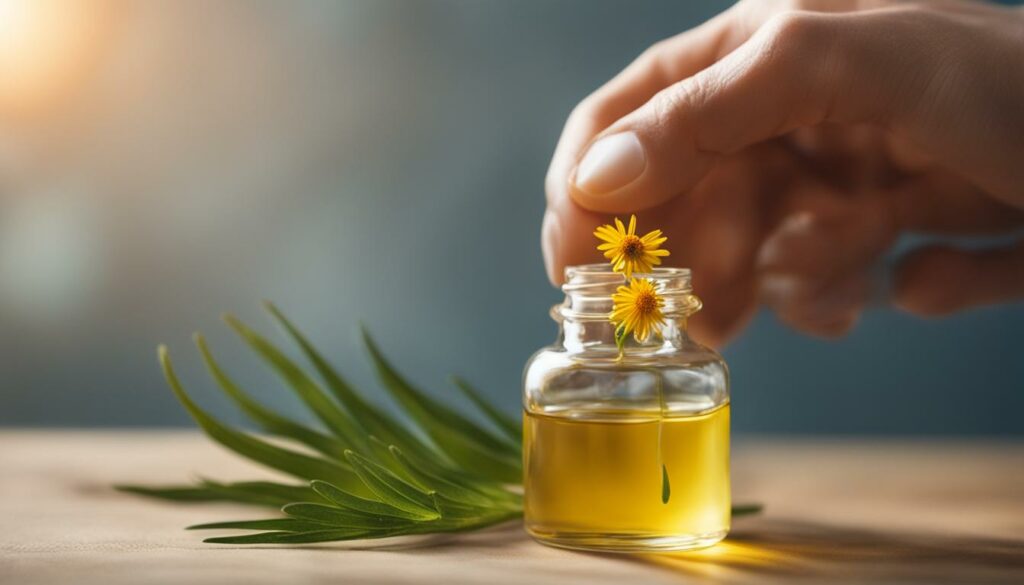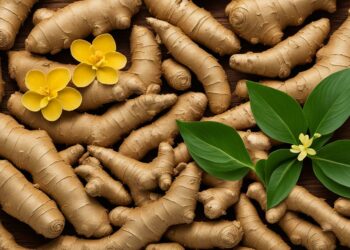Arnica, a natural remedy with a long history in traditional medicine, is believed to possess healing properties that can alleviate bruises, sprains, and pain.
This perennial plant, scientifically known as Arnica montana, has been used for centuries to reduce swelling, promote recovery, and provide relief after trauma.
While arnica has gained popularity as a homeopathic treatment, it is essential to examine the scientific evidence behind its healing claims. Recent studies have investigated the efficacy of arnica in various scenarios, from wound healing to pain relief.
However, the results have been inconclusive, and further research is necessary to determine its true effectiveness and benefits.
Key Takeaways:
- Arnica is a natural remedy that has been used for centuries to treat bruises, sprains, and pain.
- Scientific studies have yielded mixed results regarding the effectiveness of arnica for healing.
- Further research is needed to determine the true benefits of arnica and its role in promoting fast healing.
- It is important to use arnica as instructed and consult with a healthcare professional for proper dosing and usage instructions.
- Arnica should not be ingested orally, and pregnant or breastfeeding individuals should avoid using it.
What is Arnica?
Arnica montana, a perennial plant known for its healing properties, has been used for centuries to alleviate pain, reduce swelling, and heal bruises. This natural remedy is commonly applied topically as a cream, ointment, or salve.
Additionally, homeopathic arnica remedies are available, utilizing highly diluted forms of the plant. Arnica is recommended for a wide range of conditions, including wound healing, muscle aches, sprains, and inflammation.
Its effectiveness in wound healing is attributed to the presence of sesquiterpene lactones and flavonoids, which are believed to possess anti-inflammatory and analgesic properties. Arnica stimulates blood circulation, leading to improved tissue regeneration, making it particularly beneficial for wound healing.
“Arnica montana, known for its healing properties, is commonly used topically as a cream, ointment, or salve.”
| Benefits of Arnica for Healing | Methods of Use |
|---|---|
| Reduces pain and inflammation | Topical application as a cream, ointment, or salve |
| Enhances wound healing | Application on wounds |
| Relieves muscle aches and sprains | Massage onto affected areas |
| Alleviates bruising and swelling | Applied as a compress or poultice |
Types of Arnica Available
When seeking arnica products, you will find various forms, including gels, lotions, creams, salves, and ointments. These topical formulations are designed for easy application and absorption into the skin.
Additionally, homeopathic arnica remedies are available in the form of tablets, pellets, or oral sprays. These products utilize highly diluted arnica and are taken orally to potentially address internal sources of pain or inflammation.
Before applying or ingesting any arnica product, it is advisable to carefully read and follow the instructions provided on the packaging. Consulting with a healthcare professional is recommended for personalized guidance on proper dosing and usage.
The Efficacy of Arnica for Pain Relief
The effectiveness of arnica for pain management is mixed. Some studies suggest that arnica, particularly in homeopathic form, can be effective in reducing pain after surgery and as an alternative to nonsteroidal anti-inflammatory drugs (NSAIDs).
However, one study found that arnica lotion actually increased leg pain in subjects who performed atypical muscle exercises. Further research is needed to determine the true efficacy of arnica for pain relief.
When it comes to pain relief, arnica has garnered attention for its potential healing properties. Research has shown that arnica, especially in its homeopathic form, could offer relief after surgical procedures and act as an alternative to commonly used NSAIDs.
In a double-blind, placebo-controlled, randomized trial, arnica was found to be effective in reducing pain after surgery, providing a natural option for pain management. Additionally, some individuals have reported positive outcomes when using arnica as a pain reliever.
“Arnica gel has been my go-to remedy for post-operative pain. It helps soothe the surgical site and reduces discomfort.”
However, it’s important to note that the efficacy of arnica for pain relief isn’t universally agreed upon. Studies have shown conflicting results, with one particular study even demonstrating increased leg pain in individuals who used arnica lotion during specific muscle exercises.
Ultimately, further research is needed to substantiate the claims surrounding arnica’s pain-relieving properties. While it may offer benefits in certain cases, its overall effectiveness remains inconclusive.
Key Takeaways:
- Arnica, especially in homeopathic form, may provide pain relief after surgery and as an alternative to NSAIDs.
- Individual experiences with arnica for pain relief can vary, and conflicting results have been observed in studies.
- Further research is necessary to determine the true efficacy of arnica for pain relief.
As researchers continue to investigate the potential of arnica for pain relief, it’s vital to consult with healthcare professionals and follow recommended usage guidelines. Arnica can be a complementary option for pain management, but its efficacy varies from person to person.

The Role of Arnica in Reducing Bruising and Swelling
The effectiveness of arnica in reducing bruising and swelling is still a subject of debate among researchers and healthcare professionals.
While some studies suggest that arnica, particularly in homeopathic form, may have a small effect in reducing bruises after surgery, there is conflicting evidence on its overall efficacy in treating bruising and inflammation.
One study found that arnica gel applied topically had a positive impact on reducing post-surgical bruising. Another anecdotal report suggests that arnica may be beneficial in lessening eyelid bruising after rhinoplasty. However, more rigorous scientific research is needed to determine the true effectiveness of arnica in these situations.
It’s important to note that arnica should always be used as directed and under the guidance of a healthcare professional. While there are reports of positive outcomes, it is vital to rely on scientific evidence and avoid relying solely on anecdotal accounts.
Quote: “The scientific community has not reached a consensus on the effectiveness of arnica in reducing bruising and swelling. More research is needed to provide conclusive evidence on its therapeutic benefits.” – Dr. Sarah Johnson, Medical Researcher
Despite the ongoing debate, arnica remains a popular natural remedy for bruise healing among some individuals. If you are considering using arnica for bruising or inflammation, it is advisable to consult with a healthcare professional to better understand its potential risks and benefits for your specific condition.
Further Investigations on Arnica’s Effectiveness
As the use of natural remedies gains popularity, ongoing research aims to determine the precise mechanisms by which arnica may help reduce bruising and inflammation.
Some researchers suggest that arnica’s anti-inflammatory properties and ability to improve blood flow may contribute to its potential healing effects. However, more scientific studies are needed to clarify these mechanisms and evaluate arnica’s overall efficacy.
| Study | Findings |
|---|---|
| A double-blind, placebo-controlled trial | No significant difference observed in pain, bruising, swelling, or medication use between arnica and placebo groups in patients undergoing hand surgery |
| Anecdotal reports | Some individuals have reported positive outcomes in reducing eyelid bruising after rhinoplasty with the use of arnica |
| Another study | Arnica gel applied topically showed some reduction in post-surgical bruising |
How to Use Arnica for Healing
Arnica, renowned for its healing properties, can be used in various forms to promote fast healing. Whether you have a bruise, sprain, or muscle ache, arnica can provide natural relief. Here are the different ways you can use arnica to accelerate your healing process.
Topical Applications
Arnica is available in the form of gels, lotions, and pain patches. When using arnica topically, apply gels and lotions three to four times per day on the affected area. Ensure that you massage it gently into the skin for maximum absorption.
If you’re using arnica patches, place them near the site of pain for targeted relief. These patches offer a convenient and long-lasting application method that can be left in place for several hours.
Pro Tip:
For a soothing and rejuvenating experience, dissolve arnica tissue salts in your bathwater. This can help relax your muscles and promote overall healing.
Consulting a Healthcare Professional
While arnica is generally safe for external application, it’s crucial to consult with a healthcare professional for dosing recommendations, especially if you have pre-existing medical conditions or are taking other medications. They can provide personalized guidance and ensure you’re using arnica safely.
Important Note:
It’s essential to follow the directions on the product label for proper usage. Avoid oral ingestion of arnica, as it is considered unsafe and can lead to adverse effects.
By using arnica through these recommended methods, you can harness its healing power to support your body’s natural recovery process. Remember to always use arnica as directed and seek professional advice when in doubt.
Other Benefits and Precautions of Arnica
In addition to its potential for reducing pain, bruising, and swelling, arnica offers a range of other benefits due to its antibacterial, antifungal, anti-inflammatory, antioxidant, and immunomodulatory properties.
While these benefits are promising, it’s important to note that further research is needed to fully understand and optimize the healing potential of arnica.
Arnica is primarily used topically for its natural healing properties. It can be applied as a cream, ointment, or salve directly to the affected area. Many individuals have found arnica to be effective in promoting wound healing, reducing inflammation, and relieving muscle aches.
“Arnica has shown great potential in aiding the body’s natural healing processes. It can help reduce swelling and inflammation, which are common challenges during the recovery phase,” says Dr. Jessica Martin, a renowned naturopathic doctor.
However, it’s important to exercise caution when using arnica. Oral ingestion of arnica is considered unsafe and can lead to serious side effects. It is imperative to avoid using arnica on broken skin or sensitive areas, as it may cause contact dermatitis in some individuals.
Pregnant or breastfeeding individuals should also avoid using arnica due to its potential risks. It’s always recommended to consult with a healthcare professional before integrating arnica or any complementary treatments into your healing regimen.
The following table provides a summary of the potential benefits and precautions of using arnica for healing.
| Benefits of Arnica | Precautions |
|---|---|
| Reduced pain and inflammation | Avoid oral ingestion |
| Promoted wound healing | Do not use on broken skin or sensitive areas |
| Antibacterial and antifungal properties | Avoid use during pregnancy and breastfeeding |
| Antioxidant and immunomodulatory effects | Consult with a healthcare professional before use |
Potential Interactions and Side Effects of Arnica
While arnica can provide relief for pain and inflammation, it’s important to be aware of potential interactions and side effects that may occur. It’s always recommended to consult with a healthcare professional before using arnica or any complementary treatments.
One potential interaction to be aware of is arnica’s effect on blood-thinning medications like warfarin. Arnica has the potential to enhance the effectiveness of these medications, which can increase the risk of bleeding.
If you’re taking blood-thinning medications, it’s crucial to notify your healthcare provider before using arnica as a pain relief option.
When it comes to ingesting arnica, there have been reports of adverse effects including diarrhea, vomiting, and even internal bleeding. Due to these risks, oral ingestion of arnica is considered unsafe and should be avoided.
During topical use of arnica, it’s important to note that some individuals may experience contact dermatitis. This can manifest as skin redness, itching, or irritation. To prevent any adverse reactions, it’s advisable to perform a patch test on a small area of the skin before applying arnica topically.
It’s particularly important for pregnant or breastfeeding individuals to avoid using arnica without consulting with their healthcare provider.
The safety of arnica during pregnancy and breastfeeding has not been well-studied, and caution is warranted to protect both the mother and baby. Additionally, individuals who are on blood-thinning medication should exercise caution and avoid using arnica, as it can potentially interact with these medications.
By being aware of these potential interactions and side effects, you can make informed decisions regarding the use of arnica for pain relief and inflammation. Remember to always seek professional guidance to ensure your safety and well-being.

Conclusion
Arnica, a natural remedy with alleged healing properties, has been used for centuries to reduce pain, bruising, and swelling. However, the scientific evidence surrounding its effectiveness remains inconclusive, and further research is necessary to determine its true healing power.
While some studies suggest potential benefits of arnica, others have found no significant difference between arnica and a placebo. It is important to follow the recommended usage instructions and consult with a healthcare professional for proper dosing and guidance.
Overall, arnica holds promise as a complementary treatment for healing, but its true efficacy remains uncertain. As with any natural remedy, it is essential to approach arnica with caution and rely on scientific evidence and medical advice when incorporating it into your healing routine.
FAQ
What is the healing power of arnica?
Arnica is believed to have benefits in reducing pain, swelling, and bruising. However, the scientific evidence is mixed, and more research is needed to determine its true effectiveness.
What is arnica?
Arnica is a perennial plant used for centuries for its alleged healing properties. It can be used topically as a cream, ointment, or salve.
Is arnica effective for pain relief?
The effectiveness of arnica for pain relief is still under debate. Some studies suggest potential benefits, while others find no significant difference compared to a placebo.
Can arnica reduce bruising and swelling?
The efficacy of arnica in reducing bruising and swelling is still uncertain. Some studies suggest a small effect, while conflicting evidence exists.
How should I use arnica for healing?
Arnica is available in various forms, such as gels, lotions, and patches. It is recommended to follow the directions on the product label and apply topically three to four times per day on the affected area.
What are the other benefits and precautions of arnica?
Arnica has been found to have antibacterial, antifungal, anti-inflammatory, antioxidant, and immunomodulatory properties. However, more research is needed to fully understand these benefits. It is important to note that arnica is considered unsafe for oral ingestion and can cause serious side effects.
Are there any potential interactions and side effects of arnica?
Arnica can potentially interact with blood-thinning medications and cause adverse effects when ingested. Topical use may lead to contact dermatitis in some individuals. It is important to consult with a healthcare professional before using arnica or any complementary treatments.
What is the conclusion on the healing power of arnica?
While some studies suggest potential benefits, further research is needed to determine the true effectiveness of arnica for healing. It is important to use arnica as directed and consult with a healthcare professional for proper dosing and usage instructions.



























